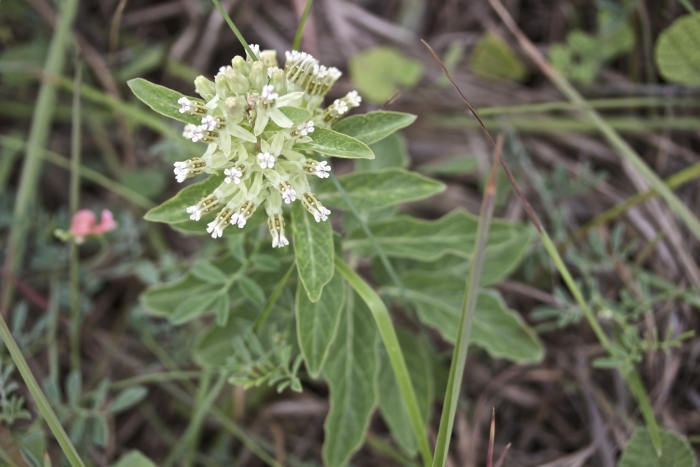Zizotes Milkweed
(Asclepias oenotheroides)
Zizotes Milkweed (Asclepias oenotheroides)
/
/

icosahedron
CC BY 4.0
Image By:
icosahedron
Recorded By:
Copyright:
CC BY 4.0
Copyright Notice:
Photo by: icosahedron | License Type: CC BY 4.0 | License URL: http://creativecommons.org/licenses/by/4.0/ | Rights Holder: icosahedron | Publisher: iNaturalist | Date Created: 2017-05-23T14:58:48-07:00 |


































Estimated Native Range
Summary
Asclepias oenotheroides, commonly known as Zizotes milkweed or Side-cluster milkweed, is a perennial herb native to prairies, open woodlands, and grasslands of the southwestern United States, Mexico, and Central America. It plays a crucial role in the lifecycle of monarch butterflies, providing a food source for caterpillars and nectar for adults. This milkweed typically grows to a height of 1-2 feet (0.3-0.6 meters) and spreads about the same. It features clusters of small, pale green to cream flowers that bloom from late spring to early fall, with each flower cluster positioned to the side of the stem, hence the name "side-cluster." The flowers are modest in size but are important for pollinators.
Zizotes milkweed is valued for its drought tolerance and ability to thrive in poor, well-drained soils, making it an excellent choice for xeriscaping and naturalized areas. It is also used in butterfly gardens and habitat restoration projects. While it prefers full sun, it can tolerate partial shade. Gardeners should be aware that, like other milkweeds, it can spread through rhizomes and self-seeding, which can be problematic if not managed. It is generally pest-free but can be susceptible to aphids and milkweed bugs.CC BY-SA 4.0
Zizotes milkweed is valued for its drought tolerance and ability to thrive in poor, well-drained soils, making it an excellent choice for xeriscaping and naturalized areas. It is also used in butterfly gardens and habitat restoration projects. While it prefers full sun, it can tolerate partial shade. Gardeners should be aware that, like other milkweeds, it can spread through rhizomes and self-seeding, which can be problematic if not managed. It is generally pest-free but can be susceptible to aphids and milkweed bugs.CC BY-SA 4.0
Plant Description
- Plant Type: Herb
- Height: 1-3 feet
- Width: 2-3 feet
- Growth Rate: Moderate
- Flower Color: Green
- Flowering Season: Spring, Summer, Fall
- Leaf Retention: Deciduous
Growth Requirements
- Sun: Full Sun
- Water: Low
- Drainage: Medium
Common Uses
Butterfly Garden, Deer Resistant, Drought Tolerant, Low Maintenance
Natural Habitat
Native to prairies, open woodlands, and grasslands
Other Names
Common Names: Sidecluster Milkweed, Hierba de Zizotes, Longhorn Milkweed
Scientific Names: , Asclepias oenotheroides, Asclepias brevicornu, Asclepias lindheimeri, Asclepias longicornu, Podostemma australe, Podostemma helleri, Podostemma lindheimeri, Podostemma longicornu,
GBIF Accepted Name: